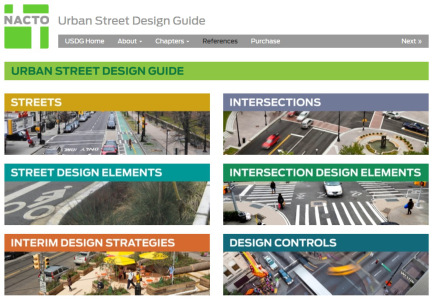Better Standards for Designing City Streets That Work for People and the Environment

In 2010, Berkeley Law’s Center for Law, Energy and the Environment, through its City Streets Project, and the Berkeley School of Environmental Design’s Center for Resource Efficient Communities issued a report that looked at the ways in which industry standards for street design can interfere with efforts to make streets more pedestrian-friendly and the encourage greater use of mass transit. We asked why cities often felt compelled to rely on standards that emphasize wide streets, narrow sidewalks and treeless corridors when what they wanted was exactly the opposite. After all, there is no legal requirement to use these industry standards. We were told that the barriers to better design included the cost of developing new guidelines and fear of liability for accidents on streets that were not built according to the prevailing rules.
We concluded that the liability fears were unfounded if a well-designed set of guidelines reflected consideration of safety concerns, and that a new standard design approach could take effect if various cities combined expertise and shared costs to create a set of rules that they could each embrace.
Members of an influential group of city designers, the National Association of Transportation Officials (NACTO) reported that they heard what we had to say and took it to heart. At least partially as a result, NACTO has released its Urban Street Design Guide. It reflects a collaboration that includes cities like Chicago, New York, San Francisco and Houston. I had the pleasure of participating in their conference in New York last year and learning about this project.
As they describe it, “The Urban Street Design Guide focuses on the design of city streets and public spaces. While other national manuals, such as AASHTO’s A Policy on Geometric Design of Highways and Streets, provide a general discussion of street design in an urban context, the Urban Street Design Guide emphasizes city street design as a unique practice with its own set of design goals, parameters, and tools.”
Sidewalks in an urban space can be wide enough to accommodate the many ways people not in cars like to move about. Trees can cool the walkways, bring birds to an urban space, and add beauty. Streets crossings can provide confidence that pedestrians can use them safely. Lane markings can encourage traffic to percolate, rather than roar. Lighting, drainage, and parking regulation can enhance energy efficiency and reduce various kinds of pollutants. Better street design can help people want to be in an urban place. The new standards provide important tools for creating this kind of environment.
Congratulations to NACTO and its dedicated members. It will be exciting to watch as their efforts on this project start to affect the urban landscape.







Reader Comments